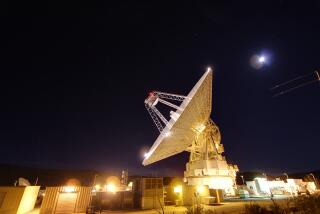Budget Limits âStar Wars,â Pentagon Says
WASHINGTON â Scientists in the Reagan Administrationâs âStar Warsâ program have scored âgenuine breakthroughsâ this year in key laser and magnetic-gun technologies, but congressional economies are delaying research into still other fields, the programâs director told a Senate Armed Services subcommittee Wednesday.
Air Force Lt. Gen. James A. Abrahamson said that House and Senate proposals to trim the Strategic Defense Initiative budget for fiscal 1986 have forced scientists to focus research on the most promising weapons technologies while neglecting important but unproved ideas.
Arguing that the U.S. space-based defense program already âhas been severely affectedâ by budget curbs, Abrahamson warned that the Soviet Union will likely be able to deploy âa fairly substantialâ anti-ballistic missile network of traditional rockets, radar and jets by the late 1980s.
Budget Argument
The testimony by Abrahamson and by Fred C. Ikle, under secretary of defense for policy, was largely aimed at convincing the Armed Services subcommittee on strategic and theater nuclear forces that the $1.4 billion spent in the last year on âStar Warsâ research has reaped enough benefits to justify the $3.7 billion that the White House is seeking for fiscal 1986.
A skeptical Senate so far has pared that request to $3 billion and a House panel to $2.5 billion. However, only the House has formally approved a Defense Department budget for the fiscal year that began Oct. 1.
Abrahamson repeated earlier assertions that research by âStar Warsâ scientists in 1985 has reaped âsignificant technical achievements,â pushing some weapons programs years ahead of schedule. Most important, he said, are advances in lasers and electromagnetic launchers, or ârail guns,â two much-touted components of future space defenses against nuclear missiles.
âWork with atmospheric compensation technologies has progressed to the point where it appears that the potential for large, effective ground-based lasers is very real,â he said.
Progress on the rail gun, which would use magnetic force to shoot high-speed projectiles at missiles, also is well ahead of schedule, Abrahamson said.
In later testimony, three leading computer scientists disputed criticsâ claims that a strategic defense system would be too complex to work in space without suffering computer software errors--such as the accidental firing of a weapon--that could trigger a full-scale nuclear response.
âIndictment of Congressâ
Whether the arguments changed any senatorsâ minds, however, was unclear. Sen. Pete Wilson (R-Calif.), a longtime supporter of the strategic defense plans, called the budget arguments âan indictment of Congress,â and Sen. Strom Thurmond (R-S.C.) said that the program would render the Soviet Union âhelplessâ in its quest for world domination.
But subcommittee chairman John W. Warner (R-Va.) said that the programâs stated objective of eliminating the threat of nuclear missiles is impossible and has created a credibility gap with congressional skeptics.
And Sen. Carl Levin (D-Mich.) charged that the White House has exaggerated Soviet progress on its space-defense program by stating that the Soviets are a decade ahead of the United States without explaining what that statement means.
Under sharp questioning, Ikle said Wednesday the statement means that the Soviets began intensive space-weapons research a decade before the United States did. But he declined to say publicly whether the United States trails the Soviets in âStar Warsâ-type weapons technology.
More to Read
Sign up for Essential California
The most important California stories and recommendations in your inbox every morning.
You may occasionally receive promotional content from the Los Angeles Times.










